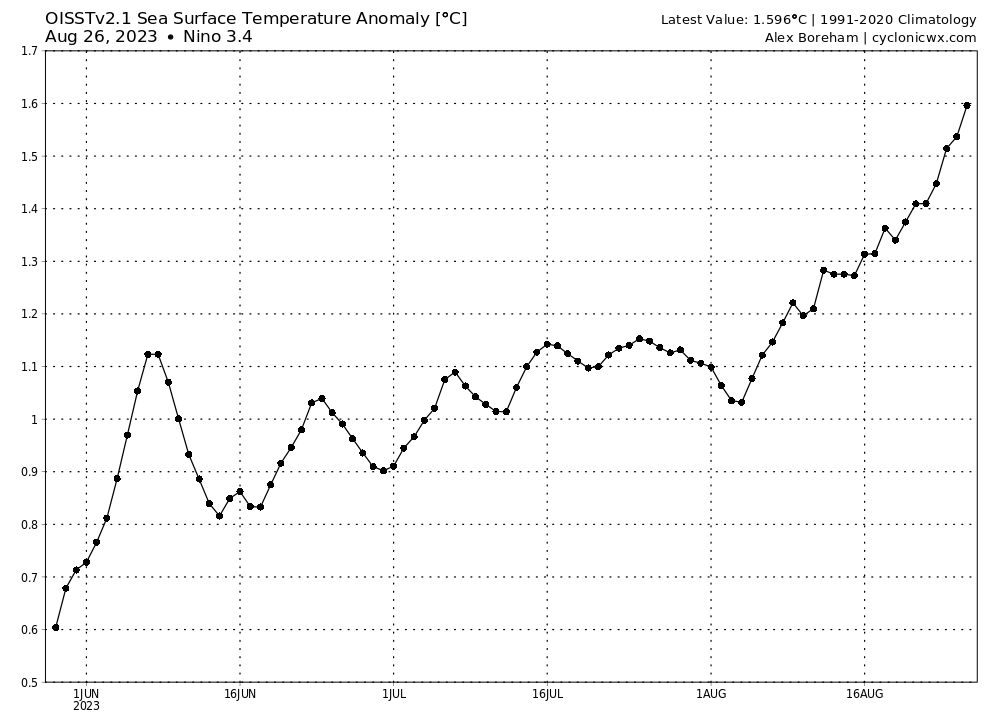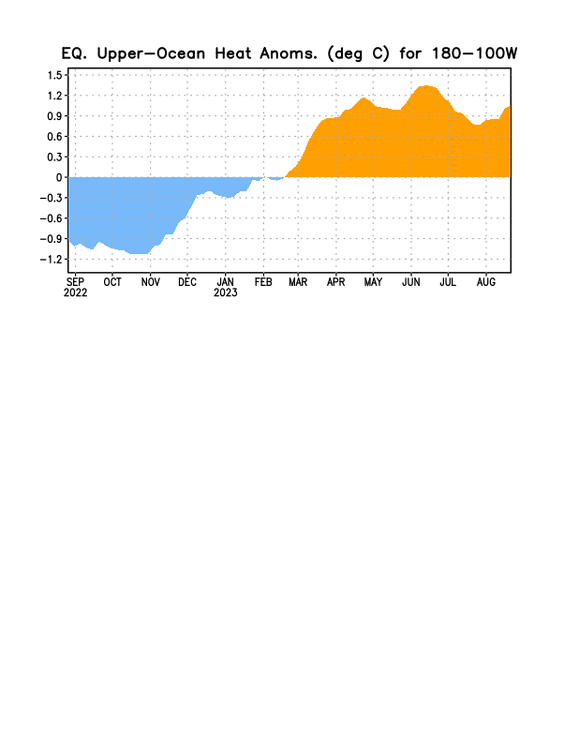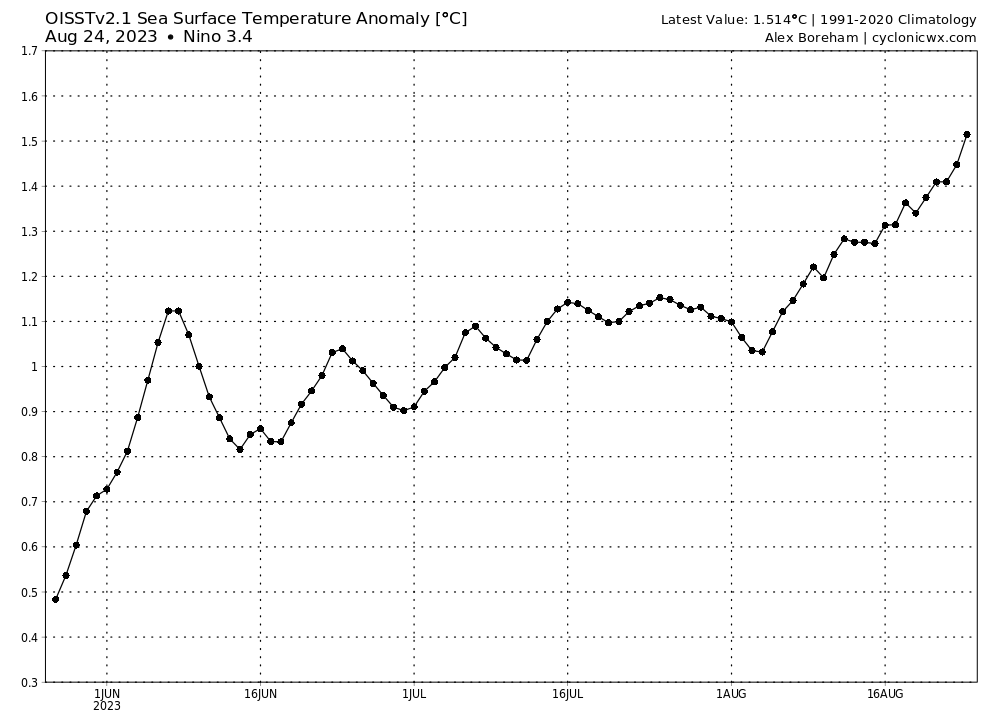
GaWx
Members-
Posts
17,693 -
Joined
Content Type
Profiles
Blogs
Forums
American Weather
Media Demo
Store
Gallery
Everything posted by GaWx
-
Euro landfalls in SE portion of Big Bend near 980 mb. It is significantly stronger and a bit further SE than recent runs. It then goes offshore 50 miles S of Savannah (mid-GA coast).
-
The average of the last 3 days of CFS runs for JFM isn't cold fwiw (I have no idea about snow as the maps don't show it). For hype purposes, he likes to post ONE run at a time when it has BN temps even though the CFS is a terrible model because that's how JB does things (just about all of us know this though): JFM precip: mainly near normal fwiw
-
Fwiw since the CFS is not a good model out just one month much less 4-6 months out, here's the CFS 2m temp anomaly (C) forecast for DJF based on the last 3 days/12 runs using 1984-2009 as base climo: (aside: Nino 3.4 SSTa peaks in Nov): Precip anomalies for DJF:
-
12Z UKMET: about same as 0Z with landfall NW part of FL Big Bend moving NNE followed by turn to NE/ENE going through south central and then SE GA. Then it goes offshore near CHS, SC: TROPICAL DEPRESSION 10L ANALYSED POSITION : 19.8N 86.1W ATCF IDENTIFIER : AL102023 LEAD CENTRAL MAXIMUM WIND VERIFYING TIME TIME POSITION PRESSURE (MB) SPEED (KNOTS) -------------- ---- -------- ------------- ------------- 1200UTC 27.08.2023 0 19.8N 86.1W 1003 24 0000UTC 28.08.2023 12 20.4N 85.3W 1001 29 1200UTC 28.08.2023 24 21.4N 85.5W 1001 33 0000UTC 29.08.2023 36 22.6N 85.8W 1001 36 1200UTC 29.08.2023 48 24.2N 86.1W 1000 34 0000UTC 30.08.2023 60 25.8N 85.5W 999 38 1200UTC 30.08.2023 72 28.6N 84.6W 995 49 0000UTC 31.08.2023 84 31.2N 82.7W 993 39 1200UTC 31.08.2023 96 33.2N 78.8W 993 43 0000UTC 01.09.2023 108 33.4N 75.0W 995 48 1200UTC 01.09.2023 120 33.8N 72.0W 999 46 0000UTC 02.09.2023 132 33.2N 69.2W 1001 43 1200UTC 02.09.2023 144 32.8N 68.4W 1003 37 0000UTC 03.09.2023 156 33.6N 65.9W 1003 35 1200UTC 03.09.2023 168 33.6N 64.5W 999 47
-
This is the strongest Euro yet as others were in low 990s at landfall and is very near the 0Z UKMET landfall point. This would be a big mess for the Big Bend wind-wise and especially storm surge-wise in this very vulnerable high poverty area as was discussed earlier ITT.
-
0Z UKMET: ~40 mile E shift at LF into NW FL Big Bend vs E Panhandle on 12Z run; once inland sharper turn to go offshore SC vs 12Z going over Augusta and then staying inland through SC into much of NC TROPICAL DEPRESSION 10L ANALYSED POSITION : 21.0N 85.5W ATCF IDENTIFIER : AL102023 LEAD CENTRAL MAXIMUM WIND VERIFYING TIME TIME POSITION PRESSURE (MB) SPEED (KNOTS) -------------- ---- -------- ------------- ------------- 0000UTC 27.08.2023 0 21.0N 85.5W 1004 25 1200UTC 27.08.2023 12 20.3N 85.6W 1002 27 0000UTC 28.08.2023 24 20.6N 85.3W 999 32 1200UTC 28.08.2023 36 21.7N 85.5W 999 35 0000UTC 29.08.2023 48 22.8N 85.5W 1000 38 1200UTC 29.08.2023 60 24.5N 85.6W 1000 41 0000UTC 30.08.2023 72 26.5N 85.3W 998 39 1200UTC 30.08.2023 84 29.2N 84.1W 995 45 0000UTC 31.08.2023 96 31.9N 81.8W 992 42 1200UTC 31.08.2023 108 33.6N 77.7W 991 43 0000UTC 01.09.2023 120 34.4N 73.4W 992 56 1200UTC 01.09.2023 132 34.4N 69.0W 996 52 0000UTC 02.09.2023 144 33.2N 65.7W 1000 45 1200UTC 02.09.2023 156 33.6N 63.2W 999 43 0000UTC 03.09.2023 168 33.5N 60.3W 997 48
-
I'm currently projecting an August ERSST 3.4 SSTa of ~+1.35. Looking at the 25 El Niño seasons since 1950, the average/median rise from Aug to peak month was 0.53/0.59 but the variation is huge from a mere .01 in 1987 and .06 in 2004 to a very large 1.09 in 1991, 1.17 in 2009, and 1.39 in 1982. To get a super ONI peak, I'd think that getting a single month peak of +2.15 would likely be enough. That would require a rise from Aug of 0.80. Only 6 of the 25 did that. Regardless, I'm expecting 2023 to be the 7th as of now based on strong model agreement. But we'll see.
-
3.4 per OISST is now +1.6, which implies ERSST is likely +1.5+. It has warmed nearly 0.3 over just the last 9 days, the fastest warming since the rapid late May/early June warmup. Through June and July, combined, when the SOI averaged ~neutral much of the time, it warmed only 0.4. But Aug has already warmed 0.5 as the SOI (often a leading indicator) has been mainly negative the last 6 weeks. Based on this graph, Monday's update should be at +1.5. Aug MTD has risen to just over +1.3. With the recent rapid rise Aug OISST is headed toward ~+1.4, implying Aug ERSST of ~~+1.35. An Aug ERSST of +1.35 would make 2023 near 1957, just behind 1972's +1.40, and much warmer than 1982's +0.98 and especially 2009's mere +0.56. But it would be quite a bit cooler than 1965's +1.66 and especially 1997's/2015's +1.91/+1.93. So, Aug of 2023 looks to be near tied with 1957 for 4th warmest for ONI. Now, RONI is a different story.
-
12Z UKMET: similar to 0Z with landfall E FL Panhandle and then NE well inland in GA: so two runs in a row that are the furthest NW by a large margin NEW TROPICAL CYCLONE FORECAST TO DEVELOP AFTER 24 HOURS FORECAST POSITION AT T+ 24 : 20.8N 86.8W LEAD CENTRAL MAXIMUM WIND VERIFYING TIME TIME POSITION PRESSURE (MB) SPEED (KNOTS) -------------- ---- -------- ------------- ------------- 1200UTC 27.08.2023 24 20.8N 86.8W 1005 20 0000UTC 28.08.2023 36 20.8N 86.4W 1003 26 1200UTC 28.08.2023 48 21.7N 86.3W 1003 29 0000UTC 29.08.2023 60 23.1N 86.9W 1002 31 1200UTC 29.08.2023 72 24.2N 87.0W 1002 43 0000UTC 30.08.2023 84 26.1N 86.3W 999 36 1200UTC 30.08.2023 96 28.8N 84.8W 996 48 0000UTC 31.08.2023 108 31.6N 83.5W 994 36 1200UTC 31.08.2023 120 33.5N 81.8W 997 37 0000UTC 01.09.2023 132 34.6N 78.5W 1002 35 1200UTC 01.09.2023 144 36.7N 74.8W 1005 39 0000UTC 02.09.2023 156 35.9N 73.6W 1006 40 1200UTC 02.09.2023 168 36.6N 69.7W 1006 36
-
0Z UK: a whopping 150 miles W of the 12Z! Also, a little stronger. Comes into Fl Panhandle and then well inland in GA. This is easily the furthest west of any UK run yet: NEW TROPICAL CYCLONE FORECAST TO DEVELOP AFTER 48 HOURS FORECAST POSITION AT T+ 48 : 21.1N 86.2W LEAD CENTRAL MAXIMUM WIND VERIFYING TIME TIME POSITION PRESSURE (MB) SPEED (KNOTS) -------------- ---- -------- ------------- ------------- 0000UTC 28.08.2023 48 21.1N 86.2W 1003 26 1200UTC 28.08.2023 60 22.2N 86.0W 1003 31 0000UTC 29.08.2023 72 23.6N 86.2W 1003 31 1200UTC 29.08.2023 84 25.6N 85.5W 1002 38 0000UTC 30.08.2023 96 28.3N 85.3W 999 36 1200UTC 30.08.2023 108 31.1N 83.7W 999 33 0000UTC 31.08.2023 120 32.9N 82.0W 996 32 1200UTC 31.08.2023 132 34.1N 79.4W 999 34 0000UTC 01.09.2023 144 33.9N 77.1W 1004 39 1200UTC 01.09.2023 156 33.1N 75.9W 1007 39 0000UTC 02.09.2023 168 32.2N 74.5W 1007 32
-
Ian formed in the C Caribbean and became a H way down below the Caymans 2.5 and a MH 1.5 days before SW FL landfall.
-
1. It isn't surprising to me that 1936 had the lowest dewpoints at Des Moines as that was during the heart of the Dust Bowl years and that July had the 3rd lowest rainfall of any during 1936-2023. The 1936 IA corn crop of 189 million bushels was by a good margin the smallest during 1936-2023 (see link). Decreased vegetation correlates well with not only hotter summer temperatures but also lower dewpoints (less evapotranspiration). The record heat and low dewpoints are naturally associated. IA Corn crop by year: https://beef2live.com/story-iowa-corn-production-year-85-205696 2. I've read a lot about the correlation between GW/CC and increased droughts. But related to GW/CC, dewpoints have increased significantly in recent decades in many places along with temperatures. I know they have here in the SE US, especially in summer. With that being the case, have relative humidities actually remained about the same? I'm asking this because the idea of increased droughts is as I understand it partially based on lower RHs due to hotter temperatures. But have RHs actually been dropping?
-
Indeed, the OHC is now pretty rapidly rebounding as I've been expecting. If I weren't expecting this rebound, I wouldn't have recently warmed my forecasted ONI to a super ONI peak (with 70% probability). It still needs to increase quite a bit more (preferably to well above the mid June high of +1.30 to +1.35) to give good support for a super ONI peak, but this is a significant start. So, the anomaly plunged ~0.60 C from mid June til ~July 20th. But over the last 30 days, it has risen 0.25 to 0.30 or nearly half of that prior 0.60 drop. I expect it to continue rebounding. If the warming rate of the last 30 days were to continue, it could get back to the mid June high as soon as late September. If so, there'd still be a two or so month long period for subsequent significant warming opportunities since OHC during a one year El Niño peaks on average in November (usually between Oct and Dec). That's when we could see this become quite impressive:
-
- This is now Invest 93L. - 12Z ICON 991 mb landfall (strongest run yet) in the Big Bend
-
12Z UKMET: track is SE of 0Z run but still landfalls near FL Big Bend; then moves NE to off the SE US; still a TS but a bit weaker than 0Z run due maybe to the further SE track (keep in mind UKMET is often conservatively low with winds): NEW TROPICAL CYCLONE FORECAST TO DEVELOP AFTER 84 HOURS FORECAST POSITION AT T+ 84 : 23.2N 85.4W LEAD CENTRAL MAXIMUM WIND VERIFYING TIME TIME POSITION PRESSURE (MB) SPEED (KNOTS) -------------- ---- -------- ------------- ------------- 0000UTC 29.08.2023 84 23.2N 85.4W 1005 31 1200UTC 29.08.2023 96 25.8N 83.9W 1002 38 0000UTC 30.08.2023 108 28.3N 82.7W 999 32 1200UTC 30.08.2023 120 31.7N 80.4W 1000 34 0000UTC 31.08.2023 132 32.8N 77.9W 1000 35 1200UTC 31.08.2023 144 33.9N 74.5W 1000 32 0000UTC 01.09.2023 156 34.3N 71.9W 1001 39 1200UTC 01.09.2023 168 34.2N 69.2W 1002 36
-
It looks like this will likely be Invest 93L shortly. Based on how the models did with Ian last year, I'll be paying somewhat extra attention to the UKMET. The reason is that it did the best by a good margin for Ian last year in having runs a good number of days out with a SW FL instead of Tampa or further north landfall. The bulk of other models had Tampa north until much closer to landfall. ICON was second best although back a ways.
-
0Z Euro ~995 mb TS landfall FL Big Bend at hour 138. Then to Jacksonville at 992 mb at 144. Heaviest rainfall 4-6" in narrow band part of N FL/SE GA.
-
Yes, +1.5C is usually considered the start of strong. So, OISST dailies have just made it to there although ERSST is likely slightly cooler. I think what he's saying is that one day, alone, isn't enough to upgrade to strong since dailies fluctuate a lot. Regardless, it is just a matter of time imo. I'm pretty confident that Sept on ERSST will be the first strong month.
-
0Z UKMET a bit stronger (60 mph when goes offshore E US at end) (UKMET often conservative with winds as 990 mb usually corresponds to stronger TS than 50 mph) with similar to 12Z run but slight NW shift. It again landfalls in the FL Big Bend and then goes NE through SE GA and then offshore from SC: NEW TROPICAL CYCLONE FORECAST TO DEVELOP AFTER 66 HOURS FORECAST POSITION AT T+ 66 : 21.4N 88.3W LEAD CENTRAL MAXIMUM WIND VERIFYING TIME TIME POSITION PRESSURE (MB) SPEED (KNOTS) -------------- ---- -------- ------------- ------------- 0000UTC 28.08.2023 72 21.3N 87.9W 1004 22 1200UTC 28.08.2023 84 23.4N 86.2W 1000 43 0000UTC 29.08.2023 96 25.1N 84.9W 996 39 1200UTC 29.08.2023 108 27.6N 84.8W 992 40 0000UTC 30.08.2023 120 29.2N 83.9W 990 43 1200UTC 30.08.2023 132 31.3N 82.0W 993 44 0000UTC 31.08.2023 144 33.1N 78.5W 991 45 1200UTC 31.08.2023 156 34.4N 74.6W 991 48 0000UTC 01.09.2023 168 35.2N 70.6W 993 52
-
Yes, Aug on OISST through today is averaging ~+1.275. It will likely end up near the +1.3 to +1.35 range for August as a whole. That implies that ERSST will probably end up near +1.25 to perhaps +1.30 for Aug.
-
Yep, obvious huge difference between controlled fire and a wild fire! Meanwhile, per model consensus, parts of the SE US are quite possibly going to be threatened (W FL)/affected by a new TC forecasted to start forming in the NW Caribbean or SE GOM this weekend and then moving NE across FL and/or further up into the SE Tue-Wed. Folks should keep an eye on this just in case although I have to go all of the way back to storm #6 of 1880 to find an analog of this in late Aug or early Sep during El Niño:
-
The 12Z UKMET (typically overly conservative model) is significantly stronger than the 0Z with the W Car/GOM TC (partially due to being over water longer) with a TS instead of just a TD and 10 mb lower SLP. Also, instead of it moving NE across S FL, it moves NE from the FL Big Bend across N FL into the Atlantic: NEW TROPICAL CYCLONE FORECAST TO DEVELOP AFTER 72 HOURS FORECAST POSITION AT T+ 72 : 20.9N 86.3W LEAD CENTRAL MAXIMUM WIND VERIFYING TIME TIME POSITION PRESSURE (MB) SPEED (KNOTS) -------------- ---- -------- ------------- ------------- 1200UTC 27.08.2023 72 20.9N 86.3W 1005 22 0000UTC 28.08.2023 84 21.2N 85.7W 1003 24 1200UTC 28.08.2023 96 22.8N 84.8W 1002 36 0000UTC 29.08.2023 108 24.8N 83.7W 1000 36 1200UTC 29.08.2023 120 27.2N 83.6W 997 38 0000UTC 30.08.2023 132 28.6N 83.4W 994 37 1200UTC 30.08.2023 144 30.3N 82.1W 994 40 0000UTC 31.08.2023 156 32.3N 79.5W 993 41 1200UTC 31.08.2023 168 34.4N 77.1W 996 39
-
This GOM threat is a tough one to predict. Whereas there's good model agreement for something, I have to go all of the way back to storm #6 of 1880 to find an El Niño with a similar track in either late Aug or early Sep: Meanwhile, the 0Z UKMET had a TD form in the W Caribbean and then move NE over S FL. The 12Z will be out shortly.
-
Good point. Indeed, if I include March, that adds as you said 2022-3 (+NAO winter), 2017-8 (+NAO winter), 2012-3 (neutral NAO winter), 2004-5 (+NAO winter), and 1980-1 (+NAO winter). So, there'd still be a lot of hope for one solid -NAO month of DJFM even without an overall -NAO winter.





